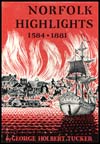Chapter 24
Music in Old Norfolk
Norfolk's earliest musical activities were principally of amateur nature with occasional performances by travelling professionals to relieve the monotony.
That there were persons in pre-Revolutionary Norfolk who could scrape a tune on a "fiddle" is well known. And it was these unknown musical tyros, many of them fiddle-playing slaves, who provided the music for the more elaborate balls at the Mason's Hall or for the more informal dances at weddings, christenings, and other festivities in the homes of the more wealthy.
It is also a matter of record that the more popular ballad operas of the period, such as "The Beggar's Opera," were performed by travelling companies on the state of Norfolk's first theater on King's Lane, while the church music of that era was restricted to the singing of metrical versions of the Psalms, the only kind of music then heard in Virginia's Anglican churches.
After the Revolution, however, when Norfolk became more cosmopolitan and the visits of professional actors and musicians became more frequent, the musical horizons of the borough broadened considerably.
According to Simmon's Norfolk directories for 1801 and 1806-7, all of the Norfolk music masters of that period were either French or German. Later, in 1818, another musician, J.H. Hoffman, advertised in the Norfolk Herald for pupils, offering to teach the "clarionet, trumpet, French horn, bugle horn, oboe, grand hautboy or voce umane, trombone, fife, German flute or additional keyed flute, flageolet, Sacbut, viel hurdy or beggars lyre, violin, violoncello, bass viol, bass drum, cymbals, etc.," an amazing offer in any period.
Norfolk's first pipe organ was installed in the first Christ Church, built in 1800 on Church Street across from the old Borough Church. Its organist, James H. Swindells, Norfolk's first recorded "minister of music" was responsible for greatly improving the quality of church music in the borough.
On May 21, 1818, Swindells, directing a large group of singers and a "band composed of several eminent professors and a number of amateurs, among which were gentlemen of cultivated taste and fine power of execution," gave an appreciative audience of over a thousand its first taste of the music of Handel, Pergolesi, and other first-rate composers.
Forty years later, on August 31, 1858, Professor Philip H. Masi, Norfolk's leading musician of his time, led a picked group of soloists and singers in the city's first rendition of Rossini's "Stabat Mater" in the recently completed St. Mary's Catholic Church at Holt and Chapel streets.
Meanwhile, serious Norfolk music lovers were increasingly receiving more generous doses of professionally performed music. Travelling opera companies, featuring better than average performances of the then standard repertoire, appeared with relative frequency at the Church Street Opera House, which opened in 1856. On its stage early in April in 1864, Louis Moreau Gottschalk, America's first internationally known pianist and matinee idol, whose celebrated "bedroom eyes" kept his female auditors in a constant state of flutter, performed "several of his latest compositions that have caused such a sensation in Boston, Philadelphia, New York, and other cities."
Professional musicians visiting Norfolk at that time also appeared at the Mechanic's Hall on Main Street, completed in 1850, that finally ended its career as the Gaiety Theater, a burlesque house, in 1960.
On January 26, 1853, the ten-year-old Adelina Patti, who was to become one of the greatest coloratura sopranos of all time, appeared there in a joint recital with the Norwegian violinist, Ole Bull, and thrilled Norfolk music lovers with her already phenomenal vocal pyrotechnics.
Chapter
25
Norfolk Theater History - Part I
Norfolk Highlights 1584 - 1881

See the "Table of Contents" for links to every chapter in Norfolk Highlights 1584 - 1881 by George Holbert Tucker.
